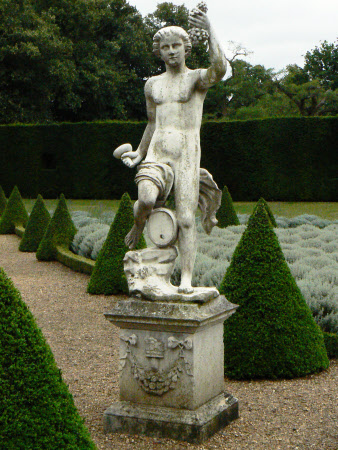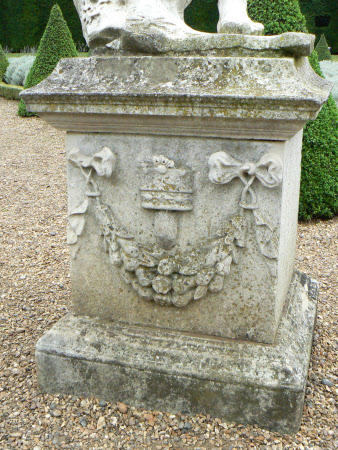Statue of Bacchus, god of wine
Category
Art / Sculpture
Date
c. 1550 - 1650
Materials
Marble
Measurements
1810 mm (H)700 mm (W)450 mm (D)
Place of origin
Italy
Order this imageCollection
Ham House, Surrey
NT 1140393.1
Summary
An Italian marble statue of Bacchus the god of wine, holding a bunch of grapes in his left hand and in his right a wine cup, whilst between his legs is a small barrel with a spigot hole. Mounted on a later rectangular marble socle. The statue was made in Italy in the late sixteenth or early seventeenth centuries.
Full description
An Italian marble statue of Bacchus the god of wine, depicting the god as a lithe young man, naked, who stands with his right leg raised and supported upon a rough rocky outcrop. In his raised left hand he holds up a bunch of grapes, whilst in his right hand he holds a large wine cup. A drapery swag passes from Bacchus’s behind round over his right thigh and between his legs. Also resting on the rocky mound is a small barrel, open at the back, whilst at the front is a hole for a spigot tap. The sculpture is mounted on a later rectangular stone socle which has, on the front side, a swag of fruit and leaves, suspended from two rings, around which are tied ribbons, and between which is a basket of flowers. The statue is cracked in places and heavily repaired, with some replacement pieces such as the right hand with the wine cup. This sculpture depicting Bacchus, the god of wine, is a typical example of the sort of large-scale figurative sculpture made in large quantities in Italy in the sixteenth and seventeenth centuries, often for display in gardens such as the Boboli gardens behind the Palazzo Pitti in Florence. In its general pose and the raising high of the left arm, the figure has reminiscences of one of the most celebrated sculptures made in early sixteenth-century Florence, the Bacchus of Jacopo Sansovino (1486-1570), made around 1510-12, after the sculptor’s return from Rome to Florence. It is feasible that the Ham House sculpture could have been made in Florence, but its fairly generic nature makes it impossible to locate it to a particular centre. The hollow wine barrel was almost certainly originally equipped with lead piping to allow it to function as some form of fountain, with either a spout or a spigot tap fixed in the hole in the front of the barrel. Jeremy Warren December 2021
Provenance
Probably acquired by William Murray, 1st Earl of Dysart (c. 1600-1655).1679 Ham House inventory, Cherry Garden, ‘One Marble Statua upon a stone pedestall’.By descent, until acquired in 1948 by HM Government when Sir Lyonel, 4th Bt (1854 – 1952) and Sir Cecil Tollemache, 5th Bt (1886 – 1969) presented Ham House to the National Trust. Entrusted to the care of the Victoria & Albert Museum until 1990, when returned to the care of the National Trust, to which ownership was transferred in 2002.
References
Avery 2013: Charles Avery, ‘Seventeenth-century Sculpture at Ham House’ in Christopher Rowell, ed., Ham House. 400 Years of History, New Haven/London 2013, pp. 158-77., p. 170, fig. 155.

